Primary History 96: Out now
The primary education journal of the Historical Association

In this edition of Primary History
Read Primary History 96: Climate and Environment
This edition of Primary History Journal is a special edition. It focuses on the challenge of climate change and the need for sustainability, a challenge that is becoming increasingly urgent. It is a joint project with Teaching History, our secondary counterpart, to which primary members have free access. We hope that these publications will help teachers see how history can be used to approach this topical and important issue. As part of this collaboration across the different age phases, Primary members will be able to access the climate edition of Teaching History as well.
Climate change is often considered through science and geography, with a little maths thrown in for data handling, but this ignores the important contribution that other areas of the curriculum offer. History too has its part to play, and in this edition we have sought to offer some ideas about how this might be done.
The beauty, fragility and vulnerability of our home planet became evident with the NASA photograph ‘Earthrise’ which we have selected for our poster this time. Those astounding images of earth provided an illustration of the beauty of our planet, our home. That floating blue marble had not been seen in its entirety before, and suddenly she was there and was both beautiful and vulnerable, generating an emotional response in many who saw her. The dangers we face if we cannot bring the ecosystems back into balance highlight our dependence on this one planet; ‘Earthrise’ shows her in all of her splendour and fragility.
Human beings are intimately connected to and affected by their physical environments and have long sought to use and control these. They have also, however, been subject to the power of nature. Natural climate change, created by volcanic eruptions, shattering earthquakes and tsunamis, has overwhelmed or destroyed previous civilisations. History allows us to explore these past events and consider how populations reacted to them. Why did some survive and others fail? Are there lessons that we can learn from these past disasters?
The infinite wonder and complexity of the natural world was once better understood by those who lived in greater harmony with it. Within this edition, we tried to show how we might reconnect with nature and see how it has witnessed the march of human history, as well as that of the seasons. We have included the story of an early eco-activist to show children that we can make a difference. We hope that the articles in this edition will provide some ideas that you can implement in your schools, showing you that history can help to explore past experiences that might suggest future actions. You will also find two articles from Alison Kitson and Michael Riley that will mirror articles in Teaching History. Catriona Ni Cassaithe suggests how we might link to previous medicinal uses of plants and herb remedies through exploring our recent past.
This resource is FREE to all registered users of the website
If you are not already registered you can sign up for FREE Basic Website Access or Join the HA to access this content.

